Buddhism in Korea: A Comparative Analysis with Chinese Mahayana Buddhism
VerifiedAdded on 2022/11/25
|14
|3310
|475
AI Summary
This research paper provides a comparative analysis of Korean Buddhism and Chinese Mahayana Buddhism. It explores the unique aspects of Korean Buddhism, including its harmonious amalgamation with Shamanism. The paper discusses the differences in philosophies, approaches, and spirituality between the two forms of Buddhism.
Contribute Materials
Your contribution can guide someone’s learning journey. Share your
documents today.

Running head: BUDDHISM IN KOREA
BUDDHISM IN KOREA
Name of the student
Name of the University
Author Note
BUDDHISM IN KOREA
Name of the student
Name of the University
Author Note
Secure Best Marks with AI Grader
Need help grading? Try our AI Grader for instant feedback on your assignments.
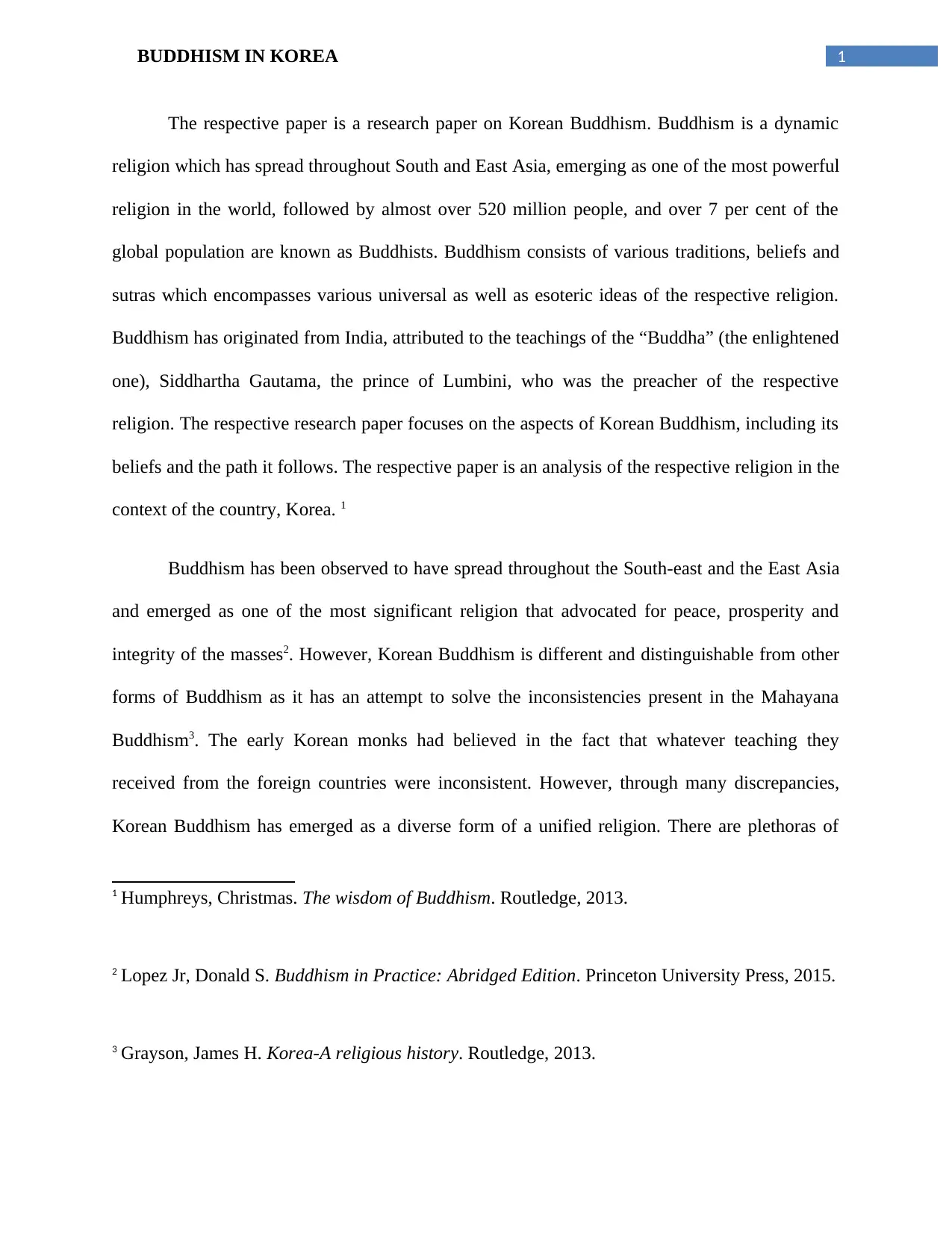
1BUDDHISM IN KOREA
The respective paper is a research paper on Korean Buddhism. Buddhism is a dynamic
religion which has spread throughout South and East Asia, emerging as one of the most powerful
religion in the world, followed by almost over 520 million people, and over 7 per cent of the
global population are known as Buddhists. Buddhism consists of various traditions, beliefs and
sutras which encompasses various universal as well as esoteric ideas of the respective religion.
Buddhism has originated from India, attributed to the teachings of the “Buddha” (the enlightened
one), Siddhartha Gautama, the prince of Lumbini, who was the preacher of the respective
religion. The respective research paper focuses on the aspects of Korean Buddhism, including its
beliefs and the path it follows. The respective paper is an analysis of the respective religion in the
context of the country, Korea. 1
Buddhism has been observed to have spread throughout the South-east and the East Asia
and emerged as one of the most significant religion that advocated for peace, prosperity and
integrity of the masses2. However, Korean Buddhism is different and distinguishable from other
forms of Buddhism as it has an attempt to solve the inconsistencies present in the Mahayana
Buddhism3. The early Korean monks had believed in the fact that whatever teaching they
received from the foreign countries were inconsistent. However, through many discrepancies,
Korean Buddhism has emerged as a diverse form of a unified religion. There are plethoras of
1 Humphreys, Christmas. The wisdom of Buddhism. Routledge, 2013.
2 Lopez Jr, Donald S. Buddhism in Practice: Abridged Edition. Princeton University Press, 2015.
3 Grayson, James H. Korea-A religious history. Routledge, 2013.
The respective paper is a research paper on Korean Buddhism. Buddhism is a dynamic
religion which has spread throughout South and East Asia, emerging as one of the most powerful
religion in the world, followed by almost over 520 million people, and over 7 per cent of the
global population are known as Buddhists. Buddhism consists of various traditions, beliefs and
sutras which encompasses various universal as well as esoteric ideas of the respective religion.
Buddhism has originated from India, attributed to the teachings of the “Buddha” (the enlightened
one), Siddhartha Gautama, the prince of Lumbini, who was the preacher of the respective
religion. The respective research paper focuses on the aspects of Korean Buddhism, including its
beliefs and the path it follows. The respective paper is an analysis of the respective religion in the
context of the country, Korea. 1
Buddhism has been observed to have spread throughout the South-east and the East Asia
and emerged as one of the most significant religion that advocated for peace, prosperity and
integrity of the masses2. However, Korean Buddhism is different and distinguishable from other
forms of Buddhism as it has an attempt to solve the inconsistencies present in the Mahayana
Buddhism3. The early Korean monks had believed in the fact that whatever teaching they
received from the foreign countries were inconsistent. However, through many discrepancies,
Korean Buddhism has emerged as a diverse form of a unified religion. There are plethoras of
1 Humphreys, Christmas. The wisdom of Buddhism. Routledge, 2013.
2 Lopez Jr, Donald S. Buddhism in Practice: Abridged Edition. Princeton University Press, 2015.
3 Grayson, James H. Korea-A religious history. Routledge, 2013.
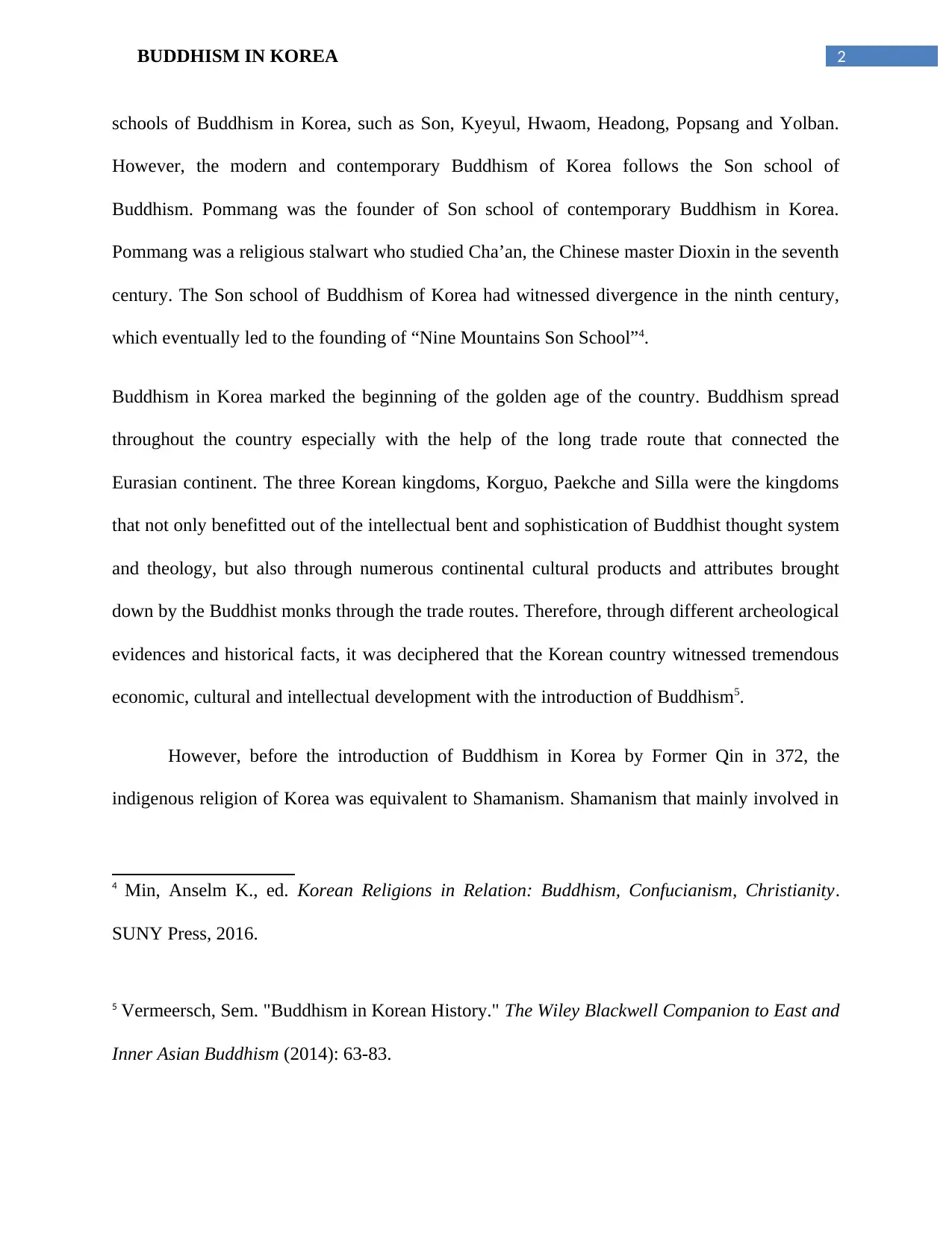
2BUDDHISM IN KOREA
schools of Buddhism in Korea, such as Son, Kyeyul, Hwaom, Headong, Popsang and Yolban.
However, the modern and contemporary Buddhism of Korea follows the Son school of
Buddhism. Pommang was the founder of Son school of contemporary Buddhism in Korea.
Pommang was a religious stalwart who studied Cha’an, the Chinese master Dioxin in the seventh
century. The Son school of Buddhism of Korea had witnessed divergence in the ninth century,
which eventually led to the founding of “Nine Mountains Son School”4.
Buddhism in Korea marked the beginning of the golden age of the country. Buddhism spread
throughout the country especially with the help of the long trade route that connected the
Eurasian continent. The three Korean kingdoms, Korguo, Paekche and Silla were the kingdoms
that not only benefitted out of the intellectual bent and sophistication of Buddhist thought system
and theology, but also through numerous continental cultural products and attributes brought
down by the Buddhist monks through the trade routes. Therefore, through different archeological
evidences and historical facts, it was deciphered that the Korean country witnessed tremendous
economic, cultural and intellectual development with the introduction of Buddhism5.
However, before the introduction of Buddhism in Korea by Former Qin in 372, the
indigenous religion of Korea was equivalent to Shamanism. Shamanism that mainly involved in
4 Min, Anselm K., ed. Korean Religions in Relation: Buddhism, Confucianism, Christianity.
SUNY Press, 2016.
5 Vermeersch, Sem. "Buddhism in Korean History." The Wiley Blackwell Companion to East and
Inner Asian Buddhism (2014): 63-83.
schools of Buddhism in Korea, such as Son, Kyeyul, Hwaom, Headong, Popsang and Yolban.
However, the modern and contemporary Buddhism of Korea follows the Son school of
Buddhism. Pommang was the founder of Son school of contemporary Buddhism in Korea.
Pommang was a religious stalwart who studied Cha’an, the Chinese master Dioxin in the seventh
century. The Son school of Buddhism of Korea had witnessed divergence in the ninth century,
which eventually led to the founding of “Nine Mountains Son School”4.
Buddhism in Korea marked the beginning of the golden age of the country. Buddhism spread
throughout the country especially with the help of the long trade route that connected the
Eurasian continent. The three Korean kingdoms, Korguo, Paekche and Silla were the kingdoms
that not only benefitted out of the intellectual bent and sophistication of Buddhist thought system
and theology, but also through numerous continental cultural products and attributes brought
down by the Buddhist monks through the trade routes. Therefore, through different archeological
evidences and historical facts, it was deciphered that the Korean country witnessed tremendous
economic, cultural and intellectual development with the introduction of Buddhism5.
However, before the introduction of Buddhism in Korea by Former Qin in 372, the
indigenous religion of Korea was equivalent to Shamanism. Shamanism that mainly involved in
4 Min, Anselm K., ed. Korean Religions in Relation: Buddhism, Confucianism, Christianity.
SUNY Press, 2016.
5 Vermeersch, Sem. "Buddhism in Korean History." The Wiley Blackwell Companion to East and
Inner Asian Buddhism (2014): 63-83.
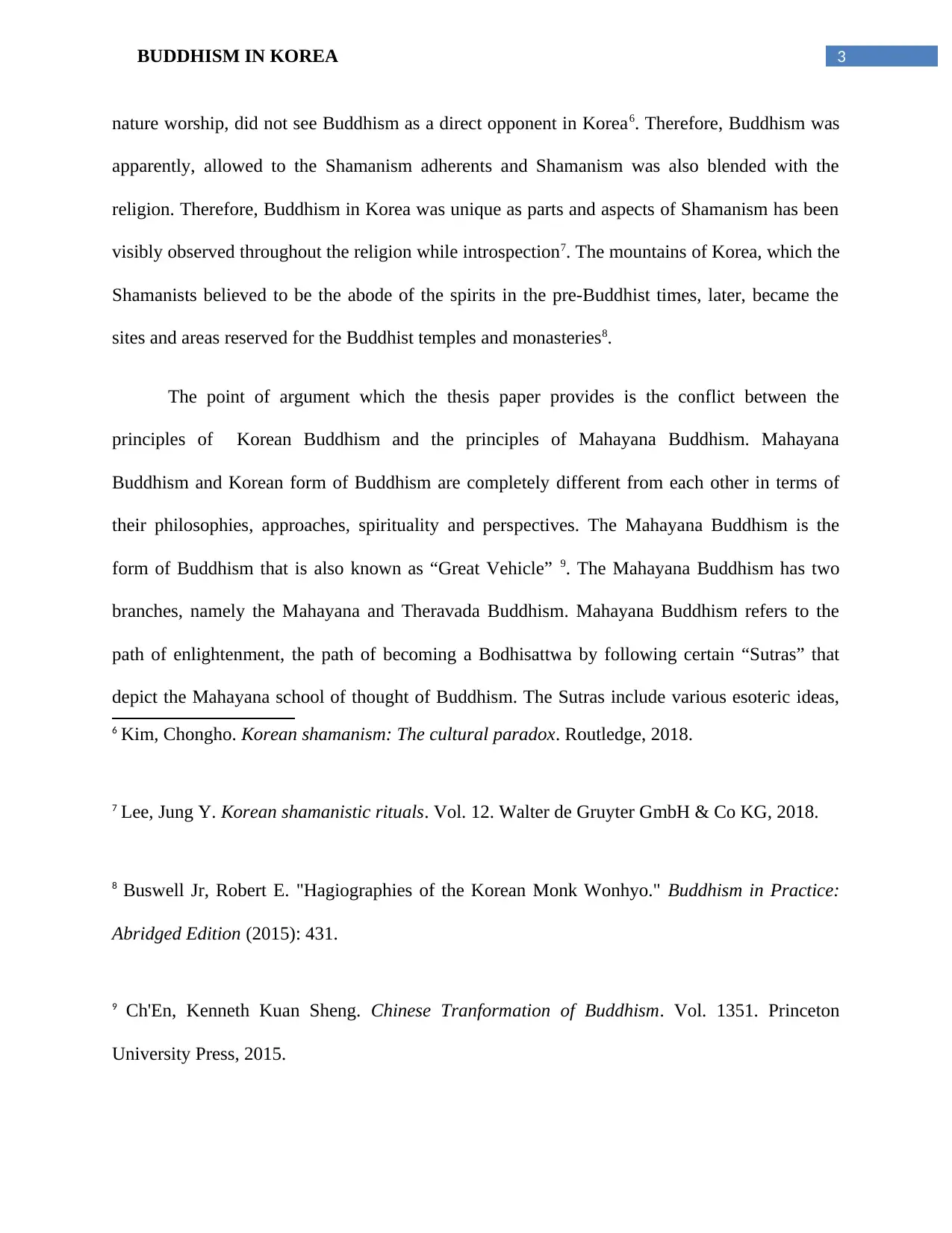
3BUDDHISM IN KOREA
nature worship, did not see Buddhism as a direct opponent in Korea6. Therefore, Buddhism was
apparently, allowed to the Shamanism adherents and Shamanism was also blended with the
religion. Therefore, Buddhism in Korea was unique as parts and aspects of Shamanism has been
visibly observed throughout the religion while introspection7. The mountains of Korea, which the
Shamanists believed to be the abode of the spirits in the pre-Buddhist times, later, became the
sites and areas reserved for the Buddhist temples and monasteries8.
The point of argument which the thesis paper provides is the conflict between the
principles of Korean Buddhism and the principles of Mahayana Buddhism. Mahayana
Buddhism and Korean form of Buddhism are completely different from each other in terms of
their philosophies, approaches, spirituality and perspectives. The Mahayana Buddhism is the
form of Buddhism that is also known as “Great Vehicle” 9. The Mahayana Buddhism has two
branches, namely the Mahayana and Theravada Buddhism. Mahayana Buddhism refers to the
path of enlightenment, the path of becoming a Bodhisattwa by following certain “Sutras” that
depict the Mahayana school of thought of Buddhism. The Sutras include various esoteric ideas,
6 Kim, Chongho. Korean shamanism: The cultural paradox. Routledge, 2018.
7 Lee, Jung Y. Korean shamanistic rituals. Vol. 12. Walter de Gruyter GmbH & Co KG, 2018.
8 Buswell Jr, Robert E. "Hagiographies of the Korean Monk Wonhyo." Buddhism in Practice:
Abridged Edition (2015): 431.
9 Ch'En, Kenneth Kuan Sheng. Chinese Tranformation of Buddhism. Vol. 1351. Princeton
University Press, 2015.
nature worship, did not see Buddhism as a direct opponent in Korea6. Therefore, Buddhism was
apparently, allowed to the Shamanism adherents and Shamanism was also blended with the
religion. Therefore, Buddhism in Korea was unique as parts and aspects of Shamanism has been
visibly observed throughout the religion while introspection7. The mountains of Korea, which the
Shamanists believed to be the abode of the spirits in the pre-Buddhist times, later, became the
sites and areas reserved for the Buddhist temples and monasteries8.
The point of argument which the thesis paper provides is the conflict between the
principles of Korean Buddhism and the principles of Mahayana Buddhism. Mahayana
Buddhism and Korean form of Buddhism are completely different from each other in terms of
their philosophies, approaches, spirituality and perspectives. The Mahayana Buddhism is the
form of Buddhism that is also known as “Great Vehicle” 9. The Mahayana Buddhism has two
branches, namely the Mahayana and Theravada Buddhism. Mahayana Buddhism refers to the
path of enlightenment, the path of becoming a Bodhisattwa by following certain “Sutras” that
depict the Mahayana school of thought of Buddhism. The Sutras include various esoteric ideas,
6 Kim, Chongho. Korean shamanism: The cultural paradox. Routledge, 2018.
7 Lee, Jung Y. Korean shamanistic rituals. Vol. 12. Walter de Gruyter GmbH & Co KG, 2018.
8 Buswell Jr, Robert E. "Hagiographies of the Korean Monk Wonhyo." Buddhism in Practice:
Abridged Edition (2015): 431.
9 Ch'En, Kenneth Kuan Sheng. Chinese Tranformation of Buddhism. Vol. 1351. Princeton
University Press, 2015.
Secure Best Marks with AI Grader
Need help grading? Try our AI Grader for instant feedback on your assignments.
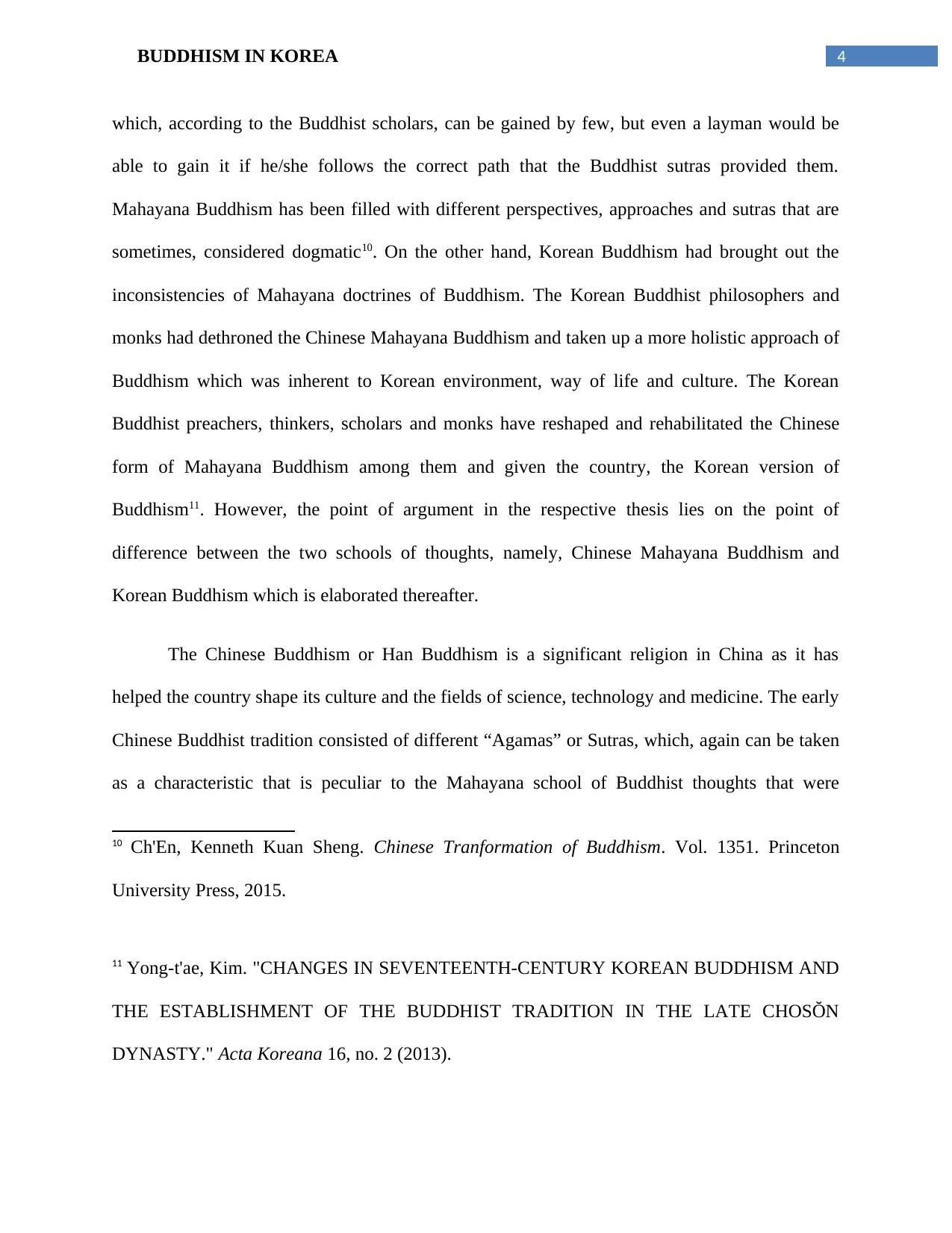
4BUDDHISM IN KOREA
which, according to the Buddhist scholars, can be gained by few, but even a layman would be
able to gain it if he/she follows the correct path that the Buddhist sutras provided them.
Mahayana Buddhism has been filled with different perspectives, approaches and sutras that are
sometimes, considered dogmatic10. On the other hand, Korean Buddhism had brought out the
inconsistencies of Mahayana doctrines of Buddhism. The Korean Buddhist philosophers and
monks had dethroned the Chinese Mahayana Buddhism and taken up a more holistic approach of
Buddhism which was inherent to Korean environment, way of life and culture. The Korean
Buddhist preachers, thinkers, scholars and monks have reshaped and rehabilitated the Chinese
form of Mahayana Buddhism among them and given the country, the Korean version of
Buddhism11. However, the point of argument in the respective thesis lies on the point of
difference between the two schools of thoughts, namely, Chinese Mahayana Buddhism and
Korean Buddhism which is elaborated thereafter.
The Chinese Buddhism or Han Buddhism is a significant religion in China as it has
helped the country shape its culture and the fields of science, technology and medicine. The early
Chinese Buddhist tradition consisted of different “Agamas” or Sutras, which, again can be taken
as a characteristic that is peculiar to the Mahayana school of Buddhist thoughts that were
10 Ch'En, Kenneth Kuan Sheng. Chinese Tranformation of Buddhism. Vol. 1351. Princeton
University Press, 2015.
11 Yong-t'ae, Kim. "CHANGES IN SEVENTEENTH-CENTURY KOREAN BUDDHISM AND
THE ESTABLISHMENT OF THE BUDDHIST TRADITION IN THE LATE CHOSŎN
DYNASTY." Acta Koreana 16, no. 2 (2013).
which, according to the Buddhist scholars, can be gained by few, but even a layman would be
able to gain it if he/she follows the correct path that the Buddhist sutras provided them.
Mahayana Buddhism has been filled with different perspectives, approaches and sutras that are
sometimes, considered dogmatic10. On the other hand, Korean Buddhism had brought out the
inconsistencies of Mahayana doctrines of Buddhism. The Korean Buddhist philosophers and
monks had dethroned the Chinese Mahayana Buddhism and taken up a more holistic approach of
Buddhism which was inherent to Korean environment, way of life and culture. The Korean
Buddhist preachers, thinkers, scholars and monks have reshaped and rehabilitated the Chinese
form of Mahayana Buddhism among them and given the country, the Korean version of
Buddhism11. However, the point of argument in the respective thesis lies on the point of
difference between the two schools of thoughts, namely, Chinese Mahayana Buddhism and
Korean Buddhism which is elaborated thereafter.
The Chinese Buddhism or Han Buddhism is a significant religion in China as it has
helped the country shape its culture and the fields of science, technology and medicine. The early
Chinese Buddhist tradition consisted of different “Agamas” or Sutras, which, again can be taken
as a characteristic that is peculiar to the Mahayana school of Buddhist thoughts that were
10 Ch'En, Kenneth Kuan Sheng. Chinese Tranformation of Buddhism. Vol. 1351. Princeton
University Press, 2015.
11 Yong-t'ae, Kim. "CHANGES IN SEVENTEENTH-CENTURY KOREAN BUDDHISM AND
THE ESTABLISHMENT OF THE BUDDHIST TRADITION IN THE LATE CHOSŎN
DYNASTY." Acta Koreana 16, no. 2 (2013).
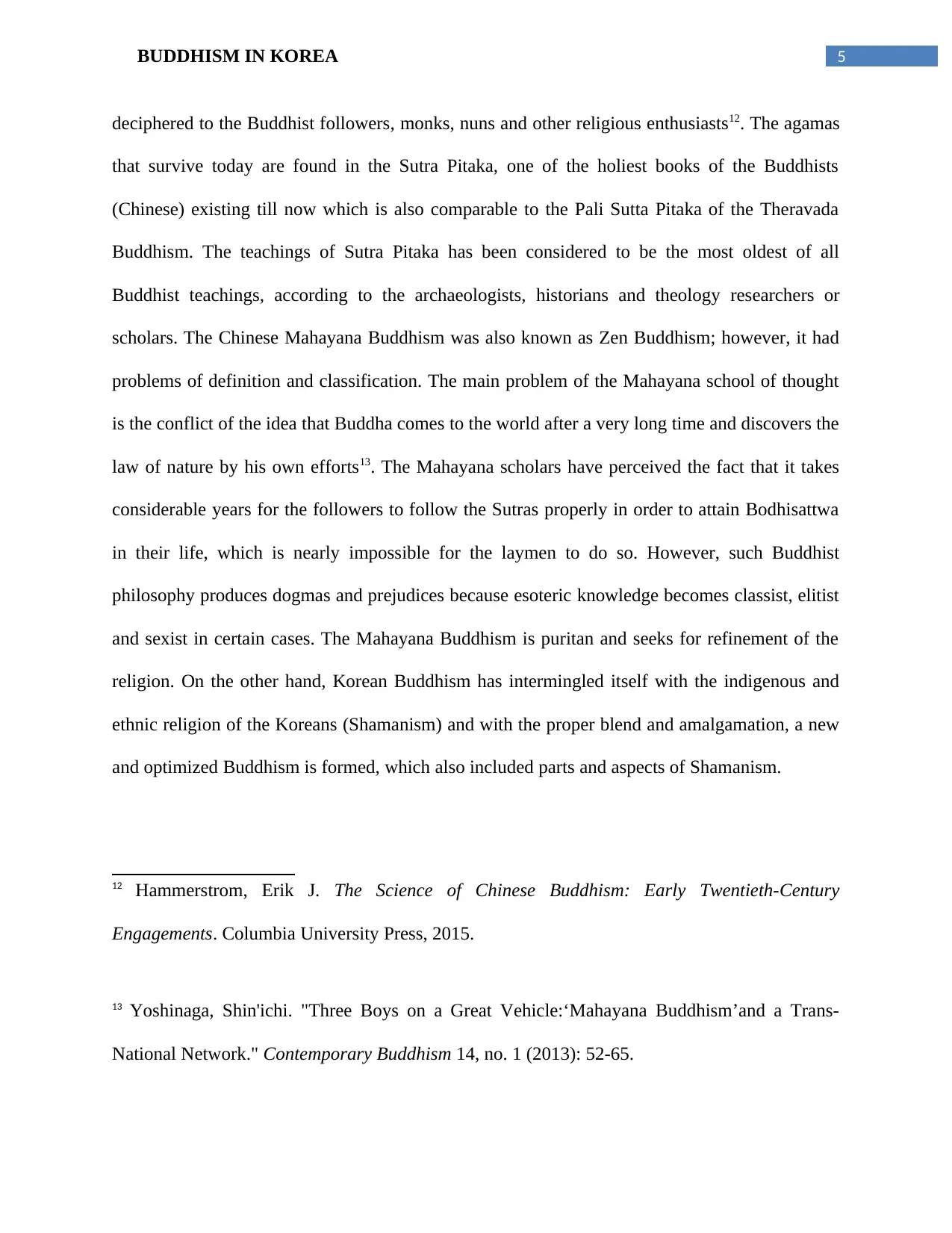
5BUDDHISM IN KOREA
deciphered to the Buddhist followers, monks, nuns and other religious enthusiasts12. The agamas
that survive today are found in the Sutra Pitaka, one of the holiest books of the Buddhists
(Chinese) existing till now which is also comparable to the Pali Sutta Pitaka of the Theravada
Buddhism. The teachings of Sutra Pitaka has been considered to be the most oldest of all
Buddhist teachings, according to the archaeologists, historians and theology researchers or
scholars. The Chinese Mahayana Buddhism was also known as Zen Buddhism; however, it had
problems of definition and classification. The main problem of the Mahayana school of thought
is the conflict of the idea that Buddha comes to the world after a very long time and discovers the
law of nature by his own efforts13. The Mahayana scholars have perceived the fact that it takes
considerable years for the followers to follow the Sutras properly in order to attain Bodhisattwa
in their life, which is nearly impossible for the laymen to do so. However, such Buddhist
philosophy produces dogmas and prejudices because esoteric knowledge becomes classist, elitist
and sexist in certain cases. The Mahayana Buddhism is puritan and seeks for refinement of the
religion. On the other hand, Korean Buddhism has intermingled itself with the indigenous and
ethnic religion of the Koreans (Shamanism) and with the proper blend and amalgamation, a new
and optimized Buddhism is formed, which also included parts and aspects of Shamanism.
12 Hammerstrom, Erik J. The Science of Chinese Buddhism: Early Twentieth-Century
Engagements. Columbia University Press, 2015.
13 Yoshinaga, Shin'ichi. "Three Boys on a Great Vehicle:‘Mahayana Buddhism’and a Trans-
National Network." Contemporary Buddhism 14, no. 1 (2013): 52-65.
deciphered to the Buddhist followers, monks, nuns and other religious enthusiasts12. The agamas
that survive today are found in the Sutra Pitaka, one of the holiest books of the Buddhists
(Chinese) existing till now which is also comparable to the Pali Sutta Pitaka of the Theravada
Buddhism. The teachings of Sutra Pitaka has been considered to be the most oldest of all
Buddhist teachings, according to the archaeologists, historians and theology researchers or
scholars. The Chinese Mahayana Buddhism was also known as Zen Buddhism; however, it had
problems of definition and classification. The main problem of the Mahayana school of thought
is the conflict of the idea that Buddha comes to the world after a very long time and discovers the
law of nature by his own efforts13. The Mahayana scholars have perceived the fact that it takes
considerable years for the followers to follow the Sutras properly in order to attain Bodhisattwa
in their life, which is nearly impossible for the laymen to do so. However, such Buddhist
philosophy produces dogmas and prejudices because esoteric knowledge becomes classist, elitist
and sexist in certain cases. The Mahayana Buddhism is puritan and seeks for refinement of the
religion. On the other hand, Korean Buddhism has intermingled itself with the indigenous and
ethnic religion of the Koreans (Shamanism) and with the proper blend and amalgamation, a new
and optimized Buddhism is formed, which also included parts and aspects of Shamanism.
12 Hammerstrom, Erik J. The Science of Chinese Buddhism: Early Twentieth-Century
Engagements. Columbia University Press, 2015.
13 Yoshinaga, Shin'ichi. "Three Boys on a Great Vehicle:‘Mahayana Buddhism’and a Trans-
National Network." Contemporary Buddhism 14, no. 1 (2013): 52-65.
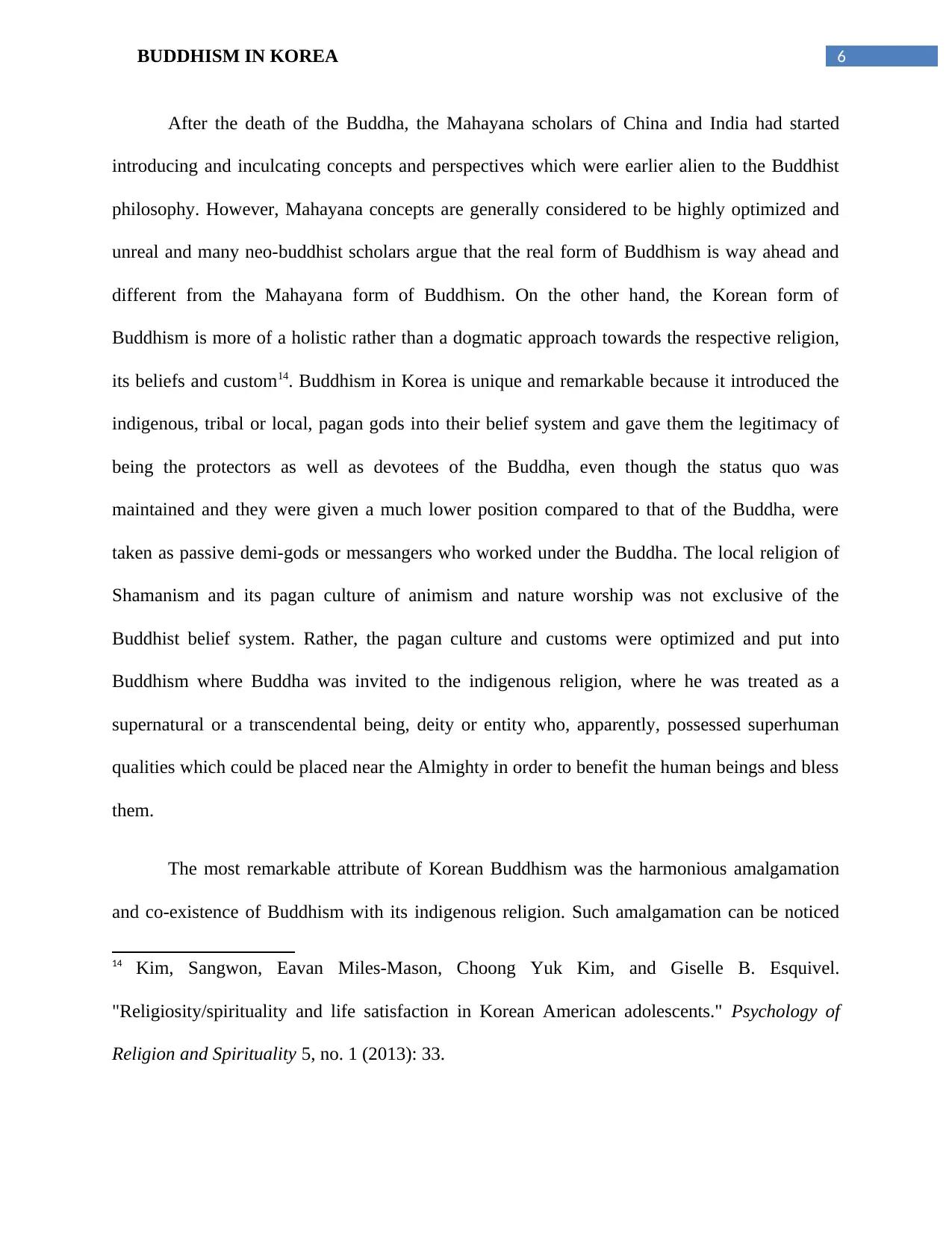
6BUDDHISM IN KOREA
After the death of the Buddha, the Mahayana scholars of China and India had started
introducing and inculcating concepts and perspectives which were earlier alien to the Buddhist
philosophy. However, Mahayana concepts are generally considered to be highly optimized and
unreal and many neo-buddhist scholars argue that the real form of Buddhism is way ahead and
different from the Mahayana form of Buddhism. On the other hand, the Korean form of
Buddhism is more of a holistic rather than a dogmatic approach towards the respective religion,
its beliefs and custom14. Buddhism in Korea is unique and remarkable because it introduced the
indigenous, tribal or local, pagan gods into their belief system and gave them the legitimacy of
being the protectors as well as devotees of the Buddha, even though the status quo was
maintained and they were given a much lower position compared to that of the Buddha, were
taken as passive demi-gods or messangers who worked under the Buddha. The local religion of
Shamanism and its pagan culture of animism and nature worship was not exclusive of the
Buddhist belief system. Rather, the pagan culture and customs were optimized and put into
Buddhism where Buddha was invited to the indigenous religion, where he was treated as a
supernatural or a transcendental being, deity or entity who, apparently, possessed superhuman
qualities which could be placed near the Almighty in order to benefit the human beings and bless
them.
The most remarkable attribute of Korean Buddhism was the harmonious amalgamation
and co-existence of Buddhism with its indigenous religion. Such amalgamation can be noticed
14 Kim, Sangwon, Eavan Miles-Mason, Choong Yuk Kim, and Giselle B. Esquivel.
"Religiosity/spirituality and life satisfaction in Korean American adolescents." Psychology of
Religion and Spirituality 5, no. 1 (2013): 33.
After the death of the Buddha, the Mahayana scholars of China and India had started
introducing and inculcating concepts and perspectives which were earlier alien to the Buddhist
philosophy. However, Mahayana concepts are generally considered to be highly optimized and
unreal and many neo-buddhist scholars argue that the real form of Buddhism is way ahead and
different from the Mahayana form of Buddhism. On the other hand, the Korean form of
Buddhism is more of a holistic rather than a dogmatic approach towards the respective religion,
its beliefs and custom14. Buddhism in Korea is unique and remarkable because it introduced the
indigenous, tribal or local, pagan gods into their belief system and gave them the legitimacy of
being the protectors as well as devotees of the Buddha, even though the status quo was
maintained and they were given a much lower position compared to that of the Buddha, were
taken as passive demi-gods or messangers who worked under the Buddha. The local religion of
Shamanism and its pagan culture of animism and nature worship was not exclusive of the
Buddhist belief system. Rather, the pagan culture and customs were optimized and put into
Buddhism where Buddha was invited to the indigenous religion, where he was treated as a
supernatural or a transcendental being, deity or entity who, apparently, possessed superhuman
qualities which could be placed near the Almighty in order to benefit the human beings and bless
them.
The most remarkable attribute of Korean Buddhism was the harmonious amalgamation
and co-existence of Buddhism with its indigenous religion. Such amalgamation can be noticed
14 Kim, Sangwon, Eavan Miles-Mason, Choong Yuk Kim, and Giselle B. Esquivel.
"Religiosity/spirituality and life satisfaction in Korean American adolescents." Psychology of
Religion and Spirituality 5, no. 1 (2013): 33.
Paraphrase This Document
Need a fresh take? Get an instant paraphrase of this document with our AI Paraphraser
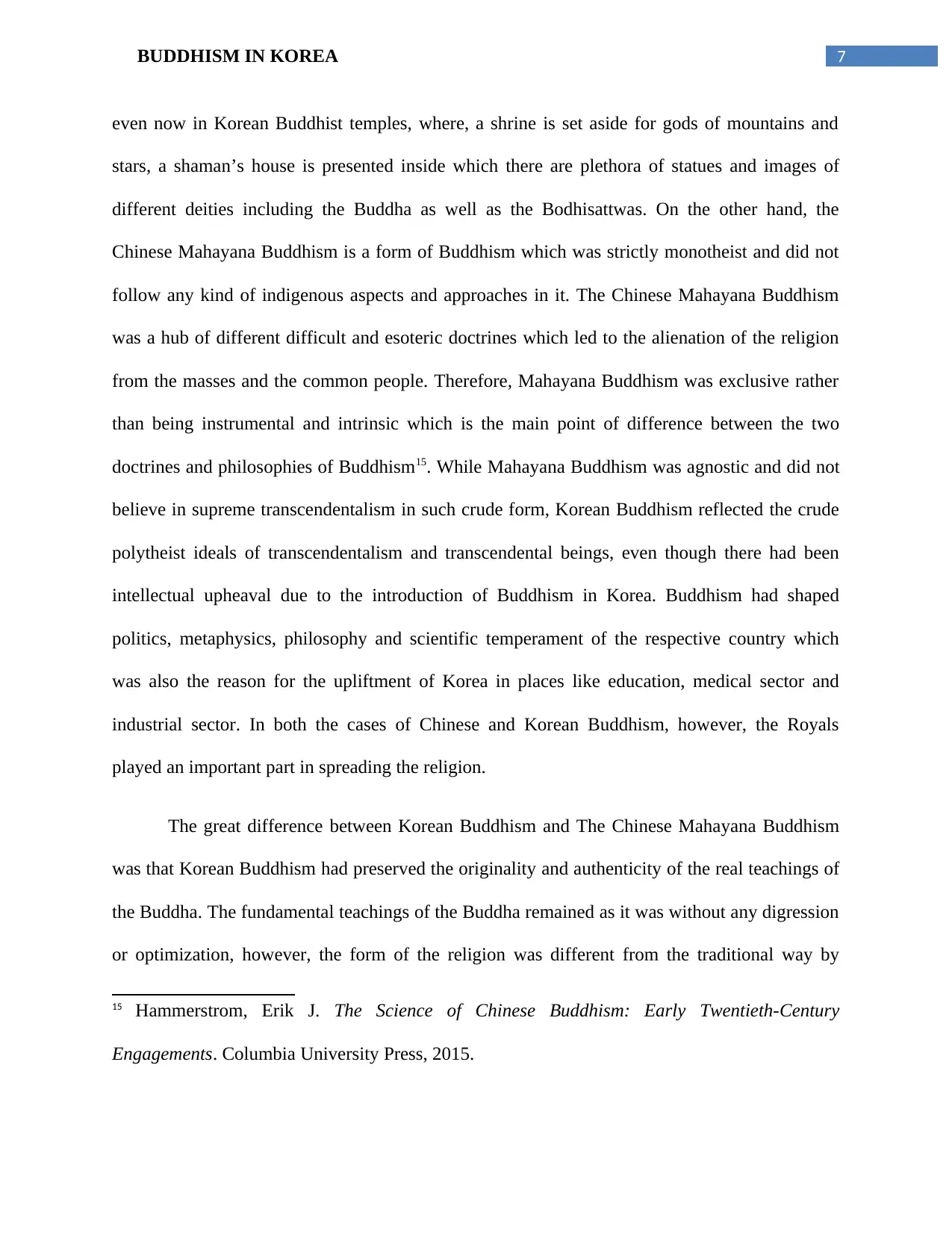
7BUDDHISM IN KOREA
even now in Korean Buddhist temples, where, a shrine is set aside for gods of mountains and
stars, a shaman’s house is presented inside which there are plethora of statues and images of
different deities including the Buddha as well as the Bodhisattwas. On the other hand, the
Chinese Mahayana Buddhism is a form of Buddhism which was strictly monotheist and did not
follow any kind of indigenous aspects and approaches in it. The Chinese Mahayana Buddhism
was a hub of different difficult and esoteric doctrines which led to the alienation of the religion
from the masses and the common people. Therefore, Mahayana Buddhism was exclusive rather
than being instrumental and intrinsic which is the main point of difference between the two
doctrines and philosophies of Buddhism15. While Mahayana Buddhism was agnostic and did not
believe in supreme transcendentalism in such crude form, Korean Buddhism reflected the crude
polytheist ideals of transcendentalism and transcendental beings, even though there had been
intellectual upheaval due to the introduction of Buddhism in Korea. Buddhism had shaped
politics, metaphysics, philosophy and scientific temperament of the respective country which
was also the reason for the upliftment of Korea in places like education, medical sector and
industrial sector. In both the cases of Chinese and Korean Buddhism, however, the Royals
played an important part in spreading the religion.
The great difference between Korean Buddhism and The Chinese Mahayana Buddhism
was that Korean Buddhism had preserved the originality and authenticity of the real teachings of
the Buddha. The fundamental teachings of the Buddha remained as it was without any digression
or optimization, however, the form of the religion was different from the traditional way by
15 Hammerstrom, Erik J. The Science of Chinese Buddhism: Early Twentieth-Century
Engagements. Columbia University Press, 2015.
even now in Korean Buddhist temples, where, a shrine is set aside for gods of mountains and
stars, a shaman’s house is presented inside which there are plethora of statues and images of
different deities including the Buddha as well as the Bodhisattwas. On the other hand, the
Chinese Mahayana Buddhism is a form of Buddhism which was strictly monotheist and did not
follow any kind of indigenous aspects and approaches in it. The Chinese Mahayana Buddhism
was a hub of different difficult and esoteric doctrines which led to the alienation of the religion
from the masses and the common people. Therefore, Mahayana Buddhism was exclusive rather
than being instrumental and intrinsic which is the main point of difference between the two
doctrines and philosophies of Buddhism15. While Mahayana Buddhism was agnostic and did not
believe in supreme transcendentalism in such crude form, Korean Buddhism reflected the crude
polytheist ideals of transcendentalism and transcendental beings, even though there had been
intellectual upheaval due to the introduction of Buddhism in Korea. Buddhism had shaped
politics, metaphysics, philosophy and scientific temperament of the respective country which
was also the reason for the upliftment of Korea in places like education, medical sector and
industrial sector. In both the cases of Chinese and Korean Buddhism, however, the Royals
played an important part in spreading the religion.
The great difference between Korean Buddhism and The Chinese Mahayana Buddhism
was that Korean Buddhism had preserved the originality and authenticity of the real teachings of
the Buddha. The fundamental teachings of the Buddha remained as it was without any digression
or optimization, however, the form of the religion was different from the traditional way by
15 Hammerstrom, Erik J. The Science of Chinese Buddhism: Early Twentieth-Century
Engagements. Columbia University Press, 2015.
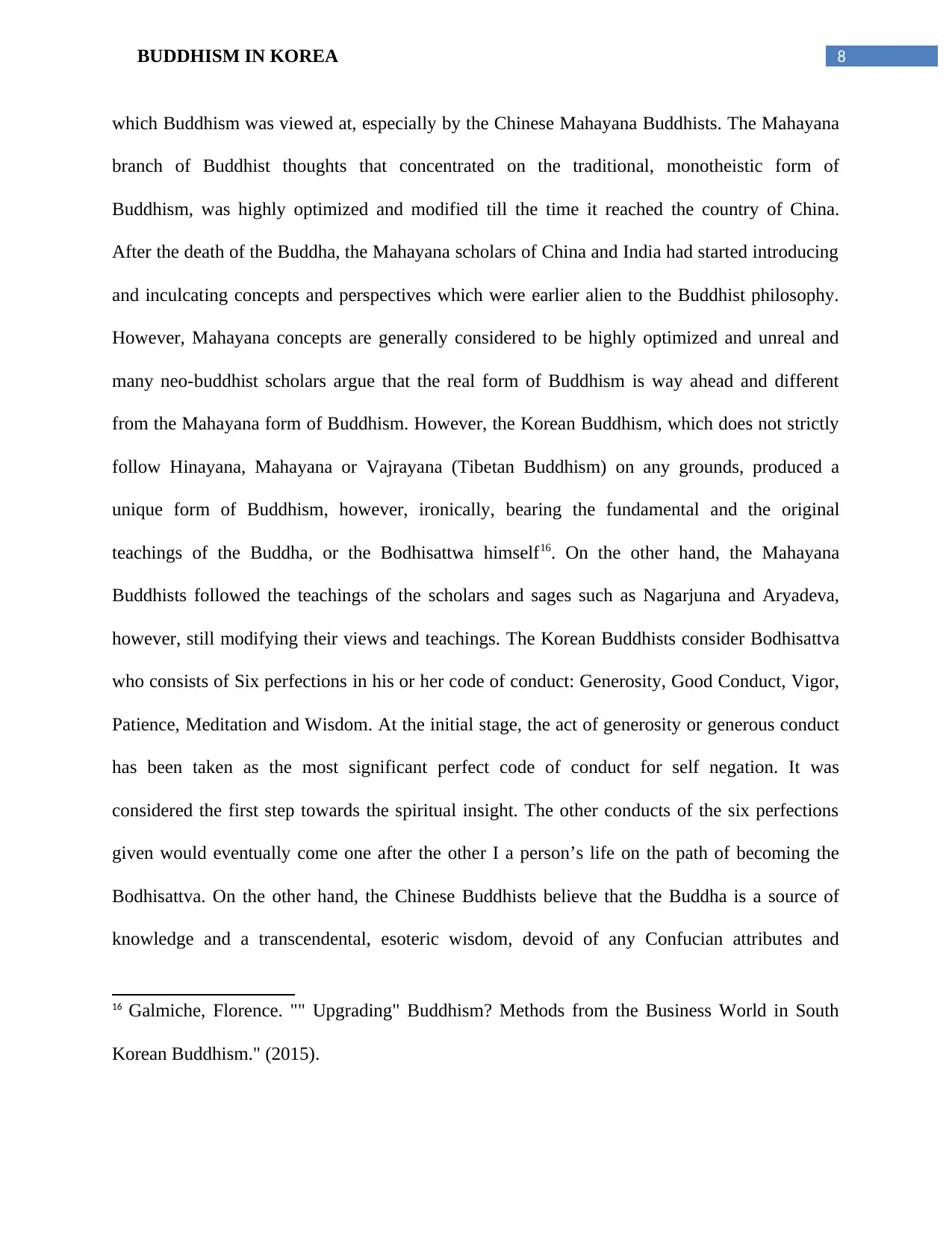
8BUDDHISM IN KOREA
which Buddhism was viewed at, especially by the Chinese Mahayana Buddhists. The Mahayana
branch of Buddhist thoughts that concentrated on the traditional, monotheistic form of
Buddhism, was highly optimized and modified till the time it reached the country of China.
After the death of the Buddha, the Mahayana scholars of China and India had started introducing
and inculcating concepts and perspectives which were earlier alien to the Buddhist philosophy.
However, Mahayana concepts are generally considered to be highly optimized and unreal and
many neo-buddhist scholars argue that the real form of Buddhism is way ahead and different
from the Mahayana form of Buddhism. However, the Korean Buddhism, which does not strictly
follow Hinayana, Mahayana or Vajrayana (Tibetan Buddhism) on any grounds, produced a
unique form of Buddhism, however, ironically, bearing the fundamental and the original
teachings of the Buddha, or the Bodhisattwa himself16. On the other hand, the Mahayana
Buddhists followed the teachings of the scholars and sages such as Nagarjuna and Aryadeva,
however, still modifying their views and teachings. The Korean Buddhists consider Bodhisattva
who consists of Six perfections in his or her code of conduct: Generosity, Good Conduct, Vigor,
Patience, Meditation and Wisdom. At the initial stage, the act of generosity or generous conduct
has been taken as the most significant perfect code of conduct for self negation. It was
considered the first step towards the spiritual insight. The other conducts of the six perfections
given would eventually come one after the other I a person’s life on the path of becoming the
Bodhisattva. On the other hand, the Chinese Buddhists believe that the Buddha is a source of
knowledge and a transcendental, esoteric wisdom, devoid of any Confucian attributes and
16 Galmiche, Florence. "" Upgrading" Buddhism? Methods from the Business World in South
Korean Buddhism." (2015).
which Buddhism was viewed at, especially by the Chinese Mahayana Buddhists. The Mahayana
branch of Buddhist thoughts that concentrated on the traditional, monotheistic form of
Buddhism, was highly optimized and modified till the time it reached the country of China.
After the death of the Buddha, the Mahayana scholars of China and India had started introducing
and inculcating concepts and perspectives which were earlier alien to the Buddhist philosophy.
However, Mahayana concepts are generally considered to be highly optimized and unreal and
many neo-buddhist scholars argue that the real form of Buddhism is way ahead and different
from the Mahayana form of Buddhism. However, the Korean Buddhism, which does not strictly
follow Hinayana, Mahayana or Vajrayana (Tibetan Buddhism) on any grounds, produced a
unique form of Buddhism, however, ironically, bearing the fundamental and the original
teachings of the Buddha, or the Bodhisattwa himself16. On the other hand, the Mahayana
Buddhists followed the teachings of the scholars and sages such as Nagarjuna and Aryadeva,
however, still modifying their views and teachings. The Korean Buddhists consider Bodhisattva
who consists of Six perfections in his or her code of conduct: Generosity, Good Conduct, Vigor,
Patience, Meditation and Wisdom. At the initial stage, the act of generosity or generous conduct
has been taken as the most significant perfect code of conduct for self negation. It was
considered the first step towards the spiritual insight. The other conducts of the six perfections
given would eventually come one after the other I a person’s life on the path of becoming the
Bodhisattva. On the other hand, the Chinese Buddhists believe that the Buddha is a source of
knowledge and a transcendental, esoteric wisdom, devoid of any Confucian attributes and
16 Galmiche, Florence. "" Upgrading" Buddhism? Methods from the Business World in South
Korean Buddhism." (2015).
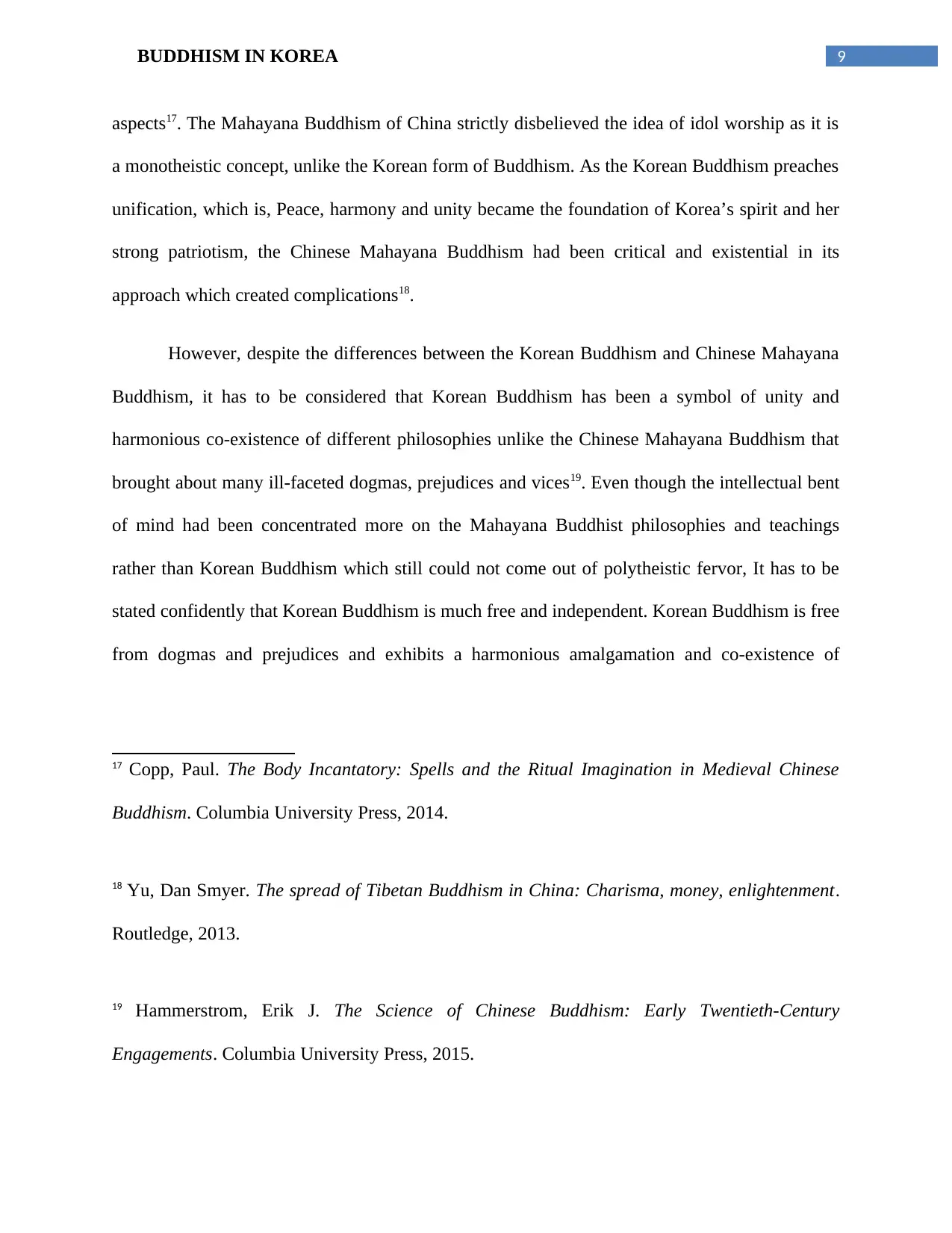
9BUDDHISM IN KOREA
aspects17. The Mahayana Buddhism of China strictly disbelieved the idea of idol worship as it is
a monotheistic concept, unlike the Korean form of Buddhism. As the Korean Buddhism preaches
unification, which is, Peace, harmony and unity became the foundation of Korea’s spirit and her
strong patriotism, the Chinese Mahayana Buddhism had been critical and existential in its
approach which created complications18.
However, despite the differences between the Korean Buddhism and Chinese Mahayana
Buddhism, it has to be considered that Korean Buddhism has been a symbol of unity and
harmonious co-existence of different philosophies unlike the Chinese Mahayana Buddhism that
brought about many ill-faceted dogmas, prejudices and vices19. Even though the intellectual bent
of mind had been concentrated more on the Mahayana Buddhist philosophies and teachings
rather than Korean Buddhism which still could not come out of polytheistic fervor, It has to be
stated confidently that Korean Buddhism is much free and independent. Korean Buddhism is free
from dogmas and prejudices and exhibits a harmonious amalgamation and co-existence of
17 Copp, Paul. The Body Incantatory: Spells and the Ritual Imagination in Medieval Chinese
Buddhism. Columbia University Press, 2014.
18 Yu, Dan Smyer. The spread of Tibetan Buddhism in China: Charisma, money, enlightenment.
Routledge, 2013.
19 Hammerstrom, Erik J. The Science of Chinese Buddhism: Early Twentieth-Century
Engagements. Columbia University Press, 2015.
aspects17. The Mahayana Buddhism of China strictly disbelieved the idea of idol worship as it is
a monotheistic concept, unlike the Korean form of Buddhism. As the Korean Buddhism preaches
unification, which is, Peace, harmony and unity became the foundation of Korea’s spirit and her
strong patriotism, the Chinese Mahayana Buddhism had been critical and existential in its
approach which created complications18.
However, despite the differences between the Korean Buddhism and Chinese Mahayana
Buddhism, it has to be considered that Korean Buddhism has been a symbol of unity and
harmonious co-existence of different philosophies unlike the Chinese Mahayana Buddhism that
brought about many ill-faceted dogmas, prejudices and vices19. Even though the intellectual bent
of mind had been concentrated more on the Mahayana Buddhist philosophies and teachings
rather than Korean Buddhism which still could not come out of polytheistic fervor, It has to be
stated confidently that Korean Buddhism is much free and independent. Korean Buddhism is free
from dogmas and prejudices and exhibits a harmonious amalgamation and co-existence of
17 Copp, Paul. The Body Incantatory: Spells and the Ritual Imagination in Medieval Chinese
Buddhism. Columbia University Press, 2014.
18 Yu, Dan Smyer. The spread of Tibetan Buddhism in China: Charisma, money, enlightenment.
Routledge, 2013.
19 Hammerstrom, Erik J. The Science of Chinese Buddhism: Early Twentieth-Century
Engagements. Columbia University Press, 2015.
Secure Best Marks with AI Grader
Need help grading? Try our AI Grader for instant feedback on your assignments.
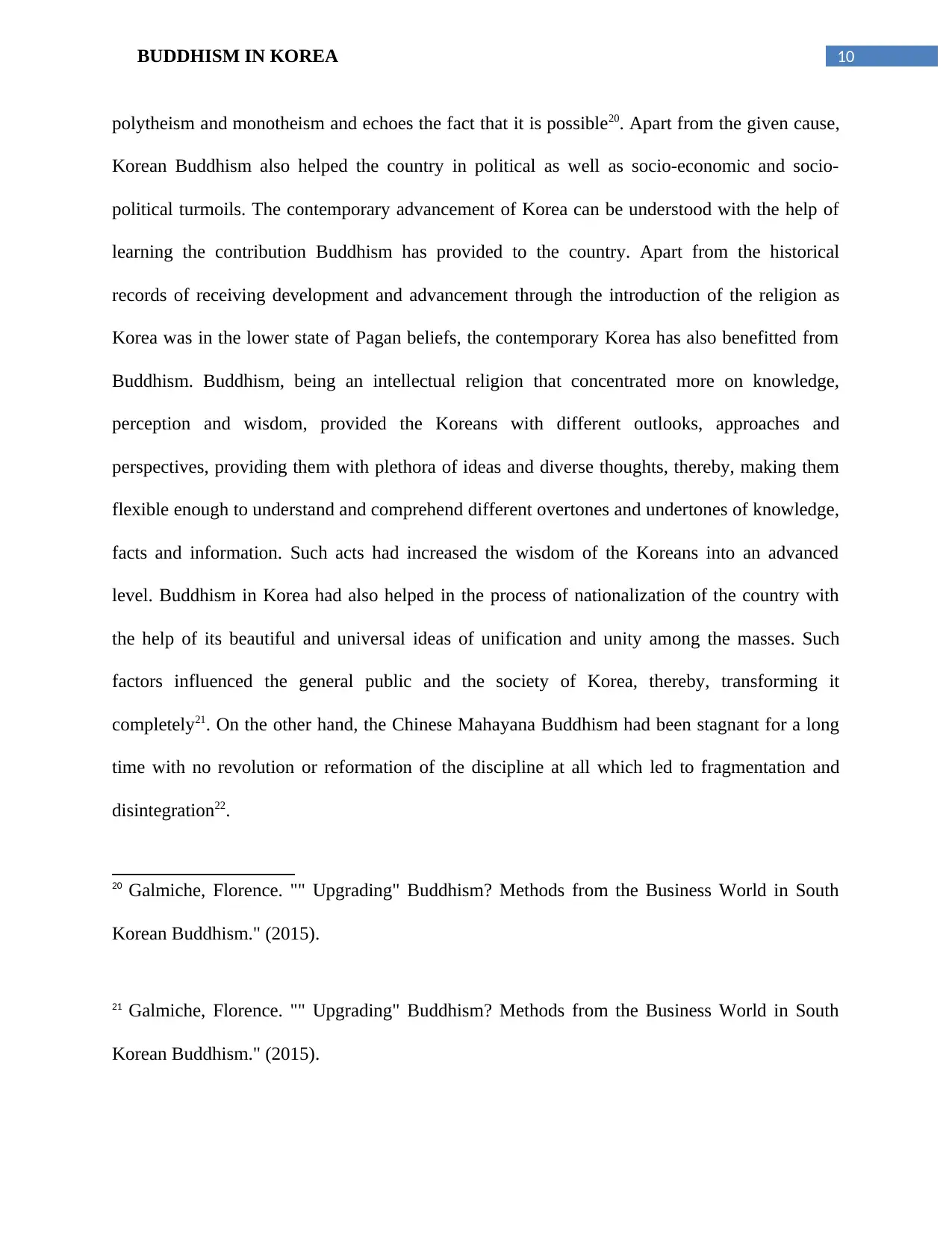
10BUDDHISM IN KOREA
polytheism and monotheism and echoes the fact that it is possible20. Apart from the given cause,
Korean Buddhism also helped the country in political as well as socio-economic and socio-
political turmoils. The contemporary advancement of Korea can be understood with the help of
learning the contribution Buddhism has provided to the country. Apart from the historical
records of receiving development and advancement through the introduction of the religion as
Korea was in the lower state of Pagan beliefs, the contemporary Korea has also benefitted from
Buddhism. Buddhism, being an intellectual religion that concentrated more on knowledge,
perception and wisdom, provided the Koreans with different outlooks, approaches and
perspectives, providing them with plethora of ideas and diverse thoughts, thereby, making them
flexible enough to understand and comprehend different overtones and undertones of knowledge,
facts and information. Such acts had increased the wisdom of the Koreans into an advanced
level. Buddhism in Korea had also helped in the process of nationalization of the country with
the help of its beautiful and universal ideas of unification and unity among the masses. Such
factors influenced the general public and the society of Korea, thereby, transforming it
completely21. On the other hand, the Chinese Mahayana Buddhism had been stagnant for a long
time with no revolution or reformation of the discipline at all which led to fragmentation and
disintegration22.
20 Galmiche, Florence. "" Upgrading" Buddhism? Methods from the Business World in South
Korean Buddhism." (2015).
21 Galmiche, Florence. "" Upgrading" Buddhism? Methods from the Business World in South
Korean Buddhism." (2015).
polytheism and monotheism and echoes the fact that it is possible20. Apart from the given cause,
Korean Buddhism also helped the country in political as well as socio-economic and socio-
political turmoils. The contemporary advancement of Korea can be understood with the help of
learning the contribution Buddhism has provided to the country. Apart from the historical
records of receiving development and advancement through the introduction of the religion as
Korea was in the lower state of Pagan beliefs, the contemporary Korea has also benefitted from
Buddhism. Buddhism, being an intellectual religion that concentrated more on knowledge,
perception and wisdom, provided the Koreans with different outlooks, approaches and
perspectives, providing them with plethora of ideas and diverse thoughts, thereby, making them
flexible enough to understand and comprehend different overtones and undertones of knowledge,
facts and information. Such acts had increased the wisdom of the Koreans into an advanced
level. Buddhism in Korea had also helped in the process of nationalization of the country with
the help of its beautiful and universal ideas of unification and unity among the masses. Such
factors influenced the general public and the society of Korea, thereby, transforming it
completely21. On the other hand, the Chinese Mahayana Buddhism had been stagnant for a long
time with no revolution or reformation of the discipline at all which led to fragmentation and
disintegration22.
20 Galmiche, Florence. "" Upgrading" Buddhism? Methods from the Business World in South
Korean Buddhism." (2015).
21 Galmiche, Florence. "" Upgrading" Buddhism? Methods from the Business World in South
Korean Buddhism." (2015).
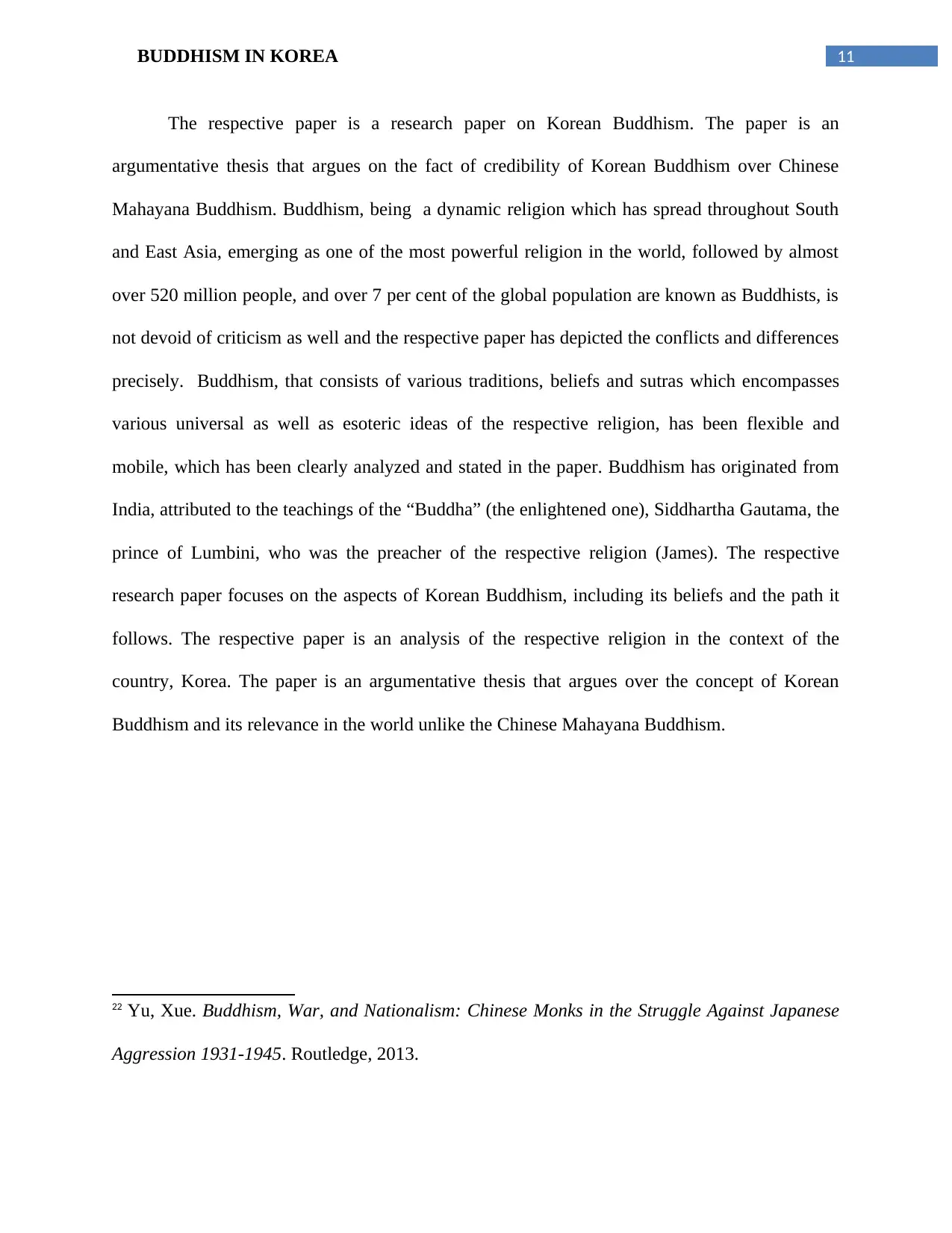
11BUDDHISM IN KOREA
The respective paper is a research paper on Korean Buddhism. The paper is an
argumentative thesis that argues on the fact of credibility of Korean Buddhism over Chinese
Mahayana Buddhism. Buddhism, being a dynamic religion which has spread throughout South
and East Asia, emerging as one of the most powerful religion in the world, followed by almost
over 520 million people, and over 7 per cent of the global population are known as Buddhists, is
not devoid of criticism as well and the respective paper has depicted the conflicts and differences
precisely. Buddhism, that consists of various traditions, beliefs and sutras which encompasses
various universal as well as esoteric ideas of the respective religion, has been flexible and
mobile, which has been clearly analyzed and stated in the paper. Buddhism has originated from
India, attributed to the teachings of the “Buddha” (the enlightened one), Siddhartha Gautama, the
prince of Lumbini, who was the preacher of the respective religion (James). The respective
research paper focuses on the aspects of Korean Buddhism, including its beliefs and the path it
follows. The respective paper is an analysis of the respective religion in the context of the
country, Korea. The paper is an argumentative thesis that argues over the concept of Korean
Buddhism and its relevance in the world unlike the Chinese Mahayana Buddhism.
22 Yu, Xue. Buddhism, War, and Nationalism: Chinese Monks in the Struggle Against Japanese
Aggression 1931-1945. Routledge, 2013.
The respective paper is a research paper on Korean Buddhism. The paper is an
argumentative thesis that argues on the fact of credibility of Korean Buddhism over Chinese
Mahayana Buddhism. Buddhism, being a dynamic religion which has spread throughout South
and East Asia, emerging as one of the most powerful religion in the world, followed by almost
over 520 million people, and over 7 per cent of the global population are known as Buddhists, is
not devoid of criticism as well and the respective paper has depicted the conflicts and differences
precisely. Buddhism, that consists of various traditions, beliefs and sutras which encompasses
various universal as well as esoteric ideas of the respective religion, has been flexible and
mobile, which has been clearly analyzed and stated in the paper. Buddhism has originated from
India, attributed to the teachings of the “Buddha” (the enlightened one), Siddhartha Gautama, the
prince of Lumbini, who was the preacher of the respective religion (James). The respective
research paper focuses on the aspects of Korean Buddhism, including its beliefs and the path it
follows. The respective paper is an analysis of the respective religion in the context of the
country, Korea. The paper is an argumentative thesis that argues over the concept of Korean
Buddhism and its relevance in the world unlike the Chinese Mahayana Buddhism.
22 Yu, Xue. Buddhism, War, and Nationalism: Chinese Monks in the Struggle Against Japanese
Aggression 1931-1945. Routledge, 2013.
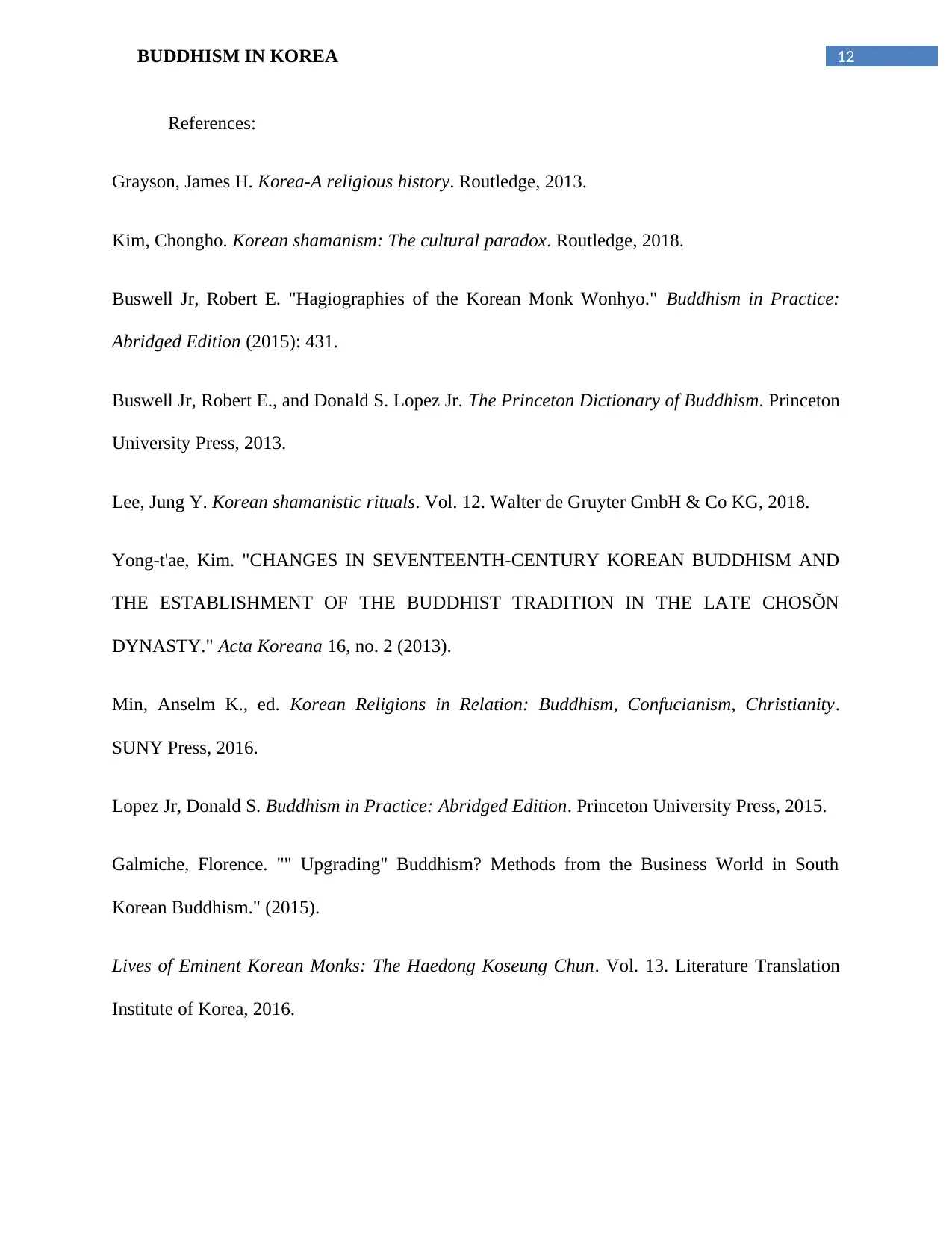
12BUDDHISM IN KOREA
References:
Grayson, James H. Korea-A religious history. Routledge, 2013.
Kim, Chongho. Korean shamanism: The cultural paradox. Routledge, 2018.
Buswell Jr, Robert E. "Hagiographies of the Korean Monk Wonhyo." Buddhism in Practice:
Abridged Edition (2015): 431.
Buswell Jr, Robert E., and Donald S. Lopez Jr. The Princeton Dictionary of Buddhism. Princeton
University Press, 2013.
Lee, Jung Y. Korean shamanistic rituals. Vol. 12. Walter de Gruyter GmbH & Co KG, 2018.
Yong-t'ae, Kim. "CHANGES IN SEVENTEENTH-CENTURY KOREAN BUDDHISM AND
THE ESTABLISHMENT OF THE BUDDHIST TRADITION IN THE LATE CHOSŎN
DYNASTY." Acta Koreana 16, no. 2 (2013).
Min, Anselm K., ed. Korean Religions in Relation: Buddhism, Confucianism, Christianity.
SUNY Press, 2016.
Lopez Jr, Donald S. Buddhism in Practice: Abridged Edition. Princeton University Press, 2015.
Galmiche, Florence. "" Upgrading" Buddhism? Methods from the Business World in South
Korean Buddhism." (2015).
Lives of Eminent Korean Monks: The Haedong Koseung Chun. Vol. 13. Literature Translation
Institute of Korea, 2016.
References:
Grayson, James H. Korea-A religious history. Routledge, 2013.
Kim, Chongho. Korean shamanism: The cultural paradox. Routledge, 2018.
Buswell Jr, Robert E. "Hagiographies of the Korean Monk Wonhyo." Buddhism in Practice:
Abridged Edition (2015): 431.
Buswell Jr, Robert E., and Donald S. Lopez Jr. The Princeton Dictionary of Buddhism. Princeton
University Press, 2013.
Lee, Jung Y. Korean shamanistic rituals. Vol. 12. Walter de Gruyter GmbH & Co KG, 2018.
Yong-t'ae, Kim. "CHANGES IN SEVENTEENTH-CENTURY KOREAN BUDDHISM AND
THE ESTABLISHMENT OF THE BUDDHIST TRADITION IN THE LATE CHOSŎN
DYNASTY." Acta Koreana 16, no. 2 (2013).
Min, Anselm K., ed. Korean Religions in Relation: Buddhism, Confucianism, Christianity.
SUNY Press, 2016.
Lopez Jr, Donald S. Buddhism in Practice: Abridged Edition. Princeton University Press, 2015.
Galmiche, Florence. "" Upgrading" Buddhism? Methods from the Business World in South
Korean Buddhism." (2015).
Lives of Eminent Korean Monks: The Haedong Koseung Chun. Vol. 13. Literature Translation
Institute of Korea, 2016.
Paraphrase This Document
Need a fresh take? Get an instant paraphrase of this document with our AI Paraphraser
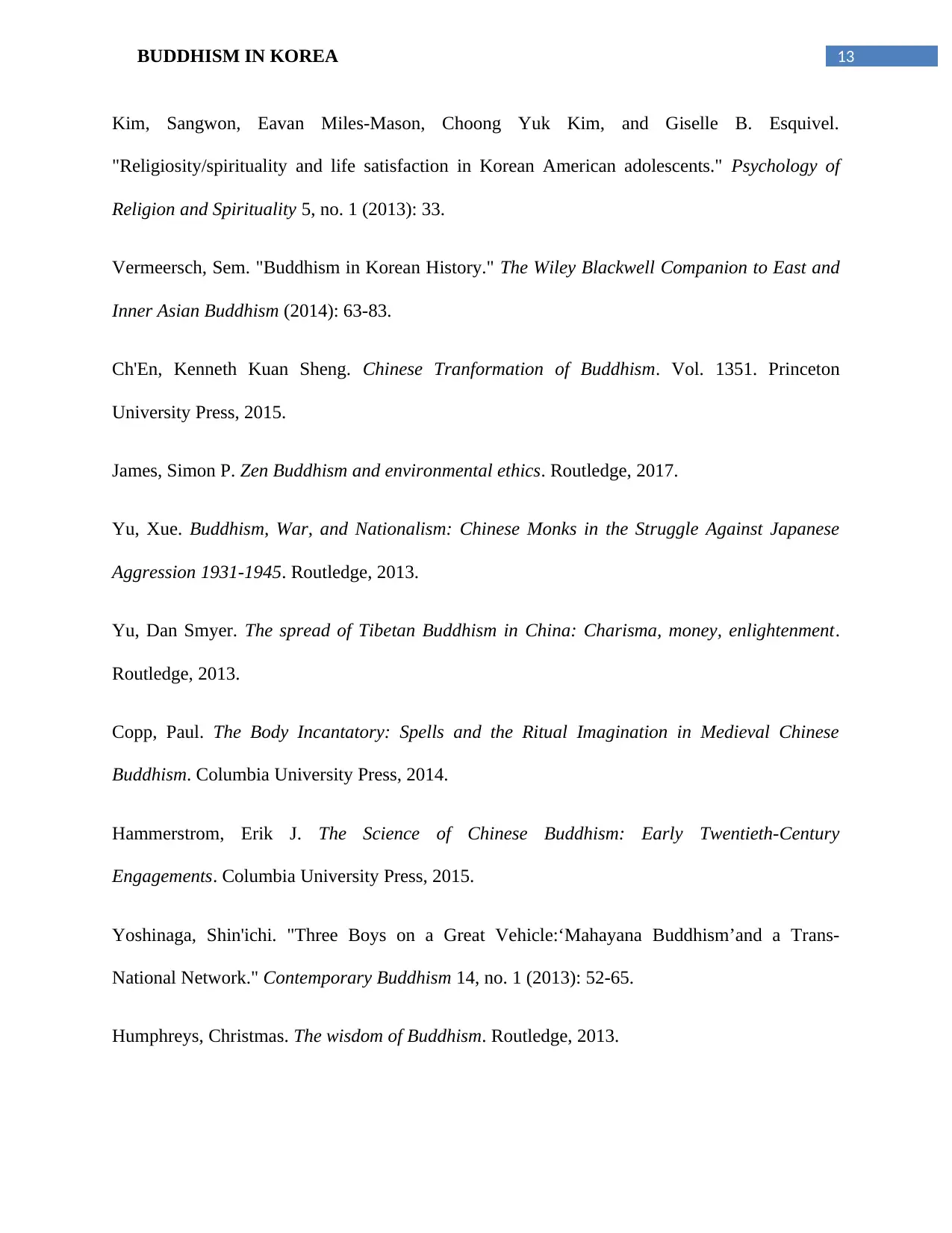
13BUDDHISM IN KOREA
Kim, Sangwon, Eavan Miles-Mason, Choong Yuk Kim, and Giselle B. Esquivel.
"Religiosity/spirituality and life satisfaction in Korean American adolescents." Psychology of
Religion and Spirituality 5, no. 1 (2013): 33.
Vermeersch, Sem. "Buddhism in Korean History." The Wiley Blackwell Companion to East and
Inner Asian Buddhism (2014): 63-83.
Ch'En, Kenneth Kuan Sheng. Chinese Tranformation of Buddhism. Vol. 1351. Princeton
University Press, 2015.
James, Simon P. Zen Buddhism and environmental ethics. Routledge, 2017.
Yu, Xue. Buddhism, War, and Nationalism: Chinese Monks in the Struggle Against Japanese
Aggression 1931-1945. Routledge, 2013.
Yu, Dan Smyer. The spread of Tibetan Buddhism in China: Charisma, money, enlightenment.
Routledge, 2013.
Copp, Paul. The Body Incantatory: Spells and the Ritual Imagination in Medieval Chinese
Buddhism. Columbia University Press, 2014.
Hammerstrom, Erik J. The Science of Chinese Buddhism: Early Twentieth-Century
Engagements. Columbia University Press, 2015.
Yoshinaga, Shin'ichi. "Three Boys on a Great Vehicle:‘Mahayana Buddhism’and a Trans-
National Network." Contemporary Buddhism 14, no. 1 (2013): 52-65.
Humphreys, Christmas. The wisdom of Buddhism. Routledge, 2013.
Kim, Sangwon, Eavan Miles-Mason, Choong Yuk Kim, and Giselle B. Esquivel.
"Religiosity/spirituality and life satisfaction in Korean American adolescents." Psychology of
Religion and Spirituality 5, no. 1 (2013): 33.
Vermeersch, Sem. "Buddhism in Korean History." The Wiley Blackwell Companion to East and
Inner Asian Buddhism (2014): 63-83.
Ch'En, Kenneth Kuan Sheng. Chinese Tranformation of Buddhism. Vol. 1351. Princeton
University Press, 2015.
James, Simon P. Zen Buddhism and environmental ethics. Routledge, 2017.
Yu, Xue. Buddhism, War, and Nationalism: Chinese Monks in the Struggle Against Japanese
Aggression 1931-1945. Routledge, 2013.
Yu, Dan Smyer. The spread of Tibetan Buddhism in China: Charisma, money, enlightenment.
Routledge, 2013.
Copp, Paul. The Body Incantatory: Spells and the Ritual Imagination in Medieval Chinese
Buddhism. Columbia University Press, 2014.
Hammerstrom, Erik J. The Science of Chinese Buddhism: Early Twentieth-Century
Engagements. Columbia University Press, 2015.
Yoshinaga, Shin'ichi. "Three Boys on a Great Vehicle:‘Mahayana Buddhism’and a Trans-
National Network." Contemporary Buddhism 14, no. 1 (2013): 52-65.
Humphreys, Christmas. The wisdom of Buddhism. Routledge, 2013.
1 out of 14
Your All-in-One AI-Powered Toolkit for Academic Success.
+13062052269
info@desklib.com
Available 24*7 on WhatsApp / Email
![[object Object]](/_next/static/media/star-bottom.7253800d.svg)
Unlock your academic potential
© 2024 | Zucol Services PVT LTD | All rights reserved.
